

Sense of identity. What is identity? What is Self Identity? Understand the Question "Who am I"? Understanding the Question ..

Who am I? Examining Our Sense of Identity and Who We Are. Who are you?
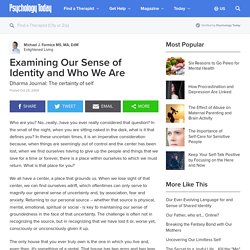
No...really...have you ever really considered that question? In the small of the night, when you are sitting naked in the dark, what is it that defines you? In these uncertain times, it is an imperative consideration because, when things are seemingly out of control and the center has been lost, when we find ourselves having to give up the people and things that we love for a time or forever, there is a place within ourselves to which we must return. Psychology Today Singapore. Identity is largely concerned largely with the question: “Who are you?”

What does it mean to be who you are? Identity relates to our basic values that dictate the choices we make (e.g., relationships, career). These choices reflect who we are and what we value. For example, we can assume that the investment banker values money, while the college professor values education and helping students. However, few people choose their identities. Article continues after advertisement. Self-Concept, Self-Identity & Social Identity – Psychology & Sociology.
Self and Identity. In the Temple of Apollo at Delphi, the ancient Greeks inscribed the words: “Know thyself.”
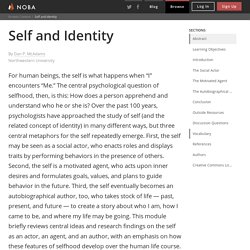
For at least 2,500 years, and probably longer, human beings have pondered the meaning of the ancient aphorism. Over the past century, psychological scientists have joined the effort. They have formulated many theories and tested countless hypotheses that speak to the central question of human selfhood: How does a person know who he or she is? The ancient Greeks seemed to realize that the self is inherently reflexive—it reflects back on itself. In the disarmingly simple idea made famous by the great psychologist William James (1892/1963), the self is what happens when “I” reflects back upon “Me.”
Imagine for a moment that you have decided to improve yourself. Although there are many different ways you might reflect upon and try to improve the self, it turns out that many, if not most, of them fall roughly into three broad psychological categories (McAdams & Cox, 2010). Erikson's psychoanalytic theory. Erik Erikson's Stages of Psychosocial Development. Erik Erikson was an ego psychologist who developed one of the most popular and influential theories of development. While his theory was impacted by psychoanalyst Sigmund Freud's work, Erikson's theory centered on psychosocial development rather than psychosexual development.
The stages that make up his theory are as follows:1. Identity vs. Role Confusion in Erikson's Theory. Identity versus confusion is the fifth stage of ego according to psychologist Erik Erikson's theory of psychosocial development.
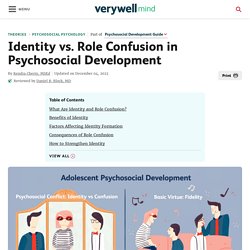
This stage occurs during adolescence between the ages of approximately 12 and 18. During this stage, adolescents explore their independence and develop a sense of self. According to Erikson, people progress through a series of stages as they grow and change throughout life. During each stage, people face a developmental conflict that must be resolved to successfully develop the primary virtue of that stage. He was interested in how social interaction and relationships affect development and growth.
Overview. Erik Erikson’s Identity Crisis: Who am I? Marcia's identity status theory. Notes on Adolescent Identity. Defining Identity Identity is a new way of thinking about oneself that emerges during adolescence.
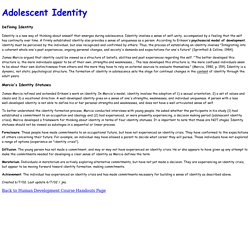
Identity involves a sense of self-unity, accompanied by a feeling that the self has continuity over time. A firmly established identity also provides a sense of uniqueness as a person. According to Erikson's psychosocialmodel of development, identity must be perceived by the individual, but also recognized and confirmed by others. Thus, the process of establishing an identity involves "Integrating into a coherent whole one's past experiences, ongoing personal changes, and society's demands and expectations for one's future" (Sprinthall & Collins, 1984).
Identity Status Theory (Marcia) Based on Erik Erikson’s groundbreaking work on identity and psychosocial development in the 1960s, Canadian developmental psychologist James Marcia refined and extended Erikson’s model, primarily focusing on adolescent development[1][2]. Addressing Erikson’s notion of identity crisis, Marcia posited that the adolescent stage consists neither of identity resolution nor identity confusion, but rather the degree to which one has explored and committed to an identity in a variety of life domains from vocation, religion, relational choices, gender roles, and so on.
Marcia’s theory of identity achievement argues that two distinct parts form an adolescent’s identity: crisis (i. e. a time when one’s values and choices are being reevaluated) and commitment. James Marcia's Adolescent Identity Development. Self Identity Problems. Identity People's identity is rooted in their identifications; in what they associated themselves with.
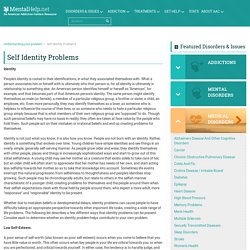
What a person associates him or herself with is ultimately who that person is, for all identity is ultimately in relationship to something else. An American person identifies himself or herself as "American", for example, and that becomes part of that American person's identity. The same person might identify themselves as male (or female), a member of a particular religious group, a brother or sister, a child, an employee, etc. Even more personally, they may identify themselves as a loser, as someone who is helpless to influence the course of their lives, or as someone who needs to hate a particular religious group simply because that is what members of their own religious group are "supposed" to do.
Identity is not just what you know; it is also how you know. Low Self-Esteem. Do you like yourself? Low Self-Efficacy. When is identity congruent with the self? A self-determination theory perspective. Keeping It in the Family: How Teenagers Use Music to Bond, Build Bridges and Seek Autonomy. Identity development and self-esteem of young adolescents in foster care. Identity in adolescence. Sex differences in identity and intimacy development in college youth. The Secret Social Media Lives of Teenagers. Many teens use shortened versions of their names or aliases for finsta accounts, which they often see as an opportunity to share a less edited, less filtered version of their lives. They might spend a lot of time trying to capture the perfect Instagram photo for the “rinsta,” which reaches a wider general audience, while a finsta might reveal, as one high school sophomore girl declared, “my innermost thoughts.”
Like the teens in the Harvard Facebook group chat, those using finsta accounts can have a false sense of confidence to say and do things they might not want a wider audience to see. How Social Media Shapes Identity. Creating a sense of identity and belonging. The Adolescent: Forging a Sense of Identity by Katelyn Freeman on Prezi. Identity SHORT FILM 2012 (Award Winning Inspirational Short)
The power of coming out: forging an identity through adversity. Lucian Freud was once asked why so many gay men sat for his portraits.

“I’ve always been friends with queers,” he said. “They’re just so brave.” Freud was sharing a truth as well as echoing Nietzsche’s most famous aphorism: “That which doesn’t kill us makes us stronger.” Being openly gay in a sometimes hostile world takes courage and resilience – qualities we all need in order to live well. Gregory M Herek, a professor of psychology at the University of California and an authority on prejudice against lesbians and gay men, says all gay people experience prejudice growing up. There is much evidence revealing the destructive impact of homophobia on gay people. “There’s this kind of naturally occurring resiliency that happens among gay men across a life course,” Stall says. The start of the transformation is “coming out” itself.
We “come out” about how we really think or feel; our profoundest loves and hates; our odd and surprising secrets.